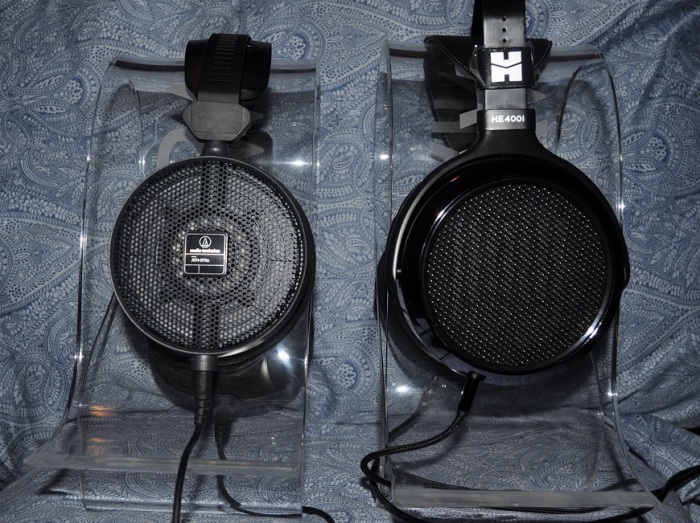
SPECS:
| HiFiMAN HE-400i | Audio Technica ATH-R70x | |
| 400i Measurements | R70x Measurements | |
| Driver Type | Single-Sided Planar | Dynamic |
| Driver Diameter | 55mm | 45mm |
| Freq. Response | 20-35,000 Hz | 5-40,000 Hz |
| Sensitivity | 93 dB / mW @ 1kHz | 99 dB / mW @ 1kHz |
| Impedance | 35 Ohms | 470 Ohms |
| Weight | 370g | 210g |
| Cable Length | 1.5m | 3m |
OVERVIEW
After receiving requests to compare the HE-400i to the ATH-R70x I decided to write this article. Not only because of the requests, but because I too was curious how the two open headphones would compare as they share several features such as being very open, comfortable, both having large drivers, and both are tricky to drive. Let’s see what similarities they have and what ultimately sets them apart.
AESTHETICS
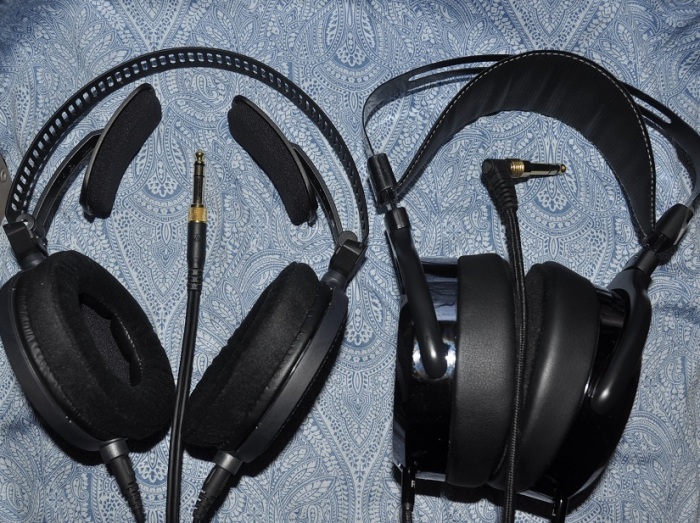
R70x ( left ) , HE-400i ( Right )
I always test aesthetics first. If a headphone does not look and feel well-made, remain comfortable for hours, or feels super cheap and poorly designed I set it aside because design aesthetics are important. Both headphones are clean-looking and well-designed with no major flaws. The HE-400i does have a short cable ( 1.5m ) which terminates into a 90 degree jack plug making it unruly at times. The R70x has an extremely long cable ( 3m ) which is great if you need the extra length, but at my desktop rig neither headphone has the ideal 2.0m cable length. The sheath on the 400i’s cable is stiff which causes it to bind and bundle. Both cables could use some improvements.
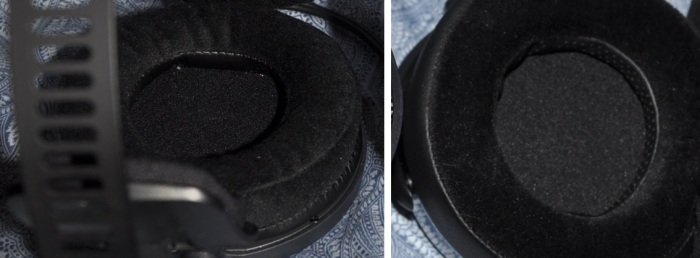
R70x ( Left ) , 400i ( RIght )
They share wonderfully comfortable earcups and both combine leatherette material with velour. The R70x has a 1cm thick velour earcup lined with leatherette while the 400i is mostly leatherette with a 1mm thick velour lining for sound filtering. The earcups on the 400i are deeper making it friendlier to larger ears. I would like to see the earcups on the R70x match the depth of the 400i for that reason. The stitching on both headphones is nicely executed, but both could use some reinforcement as the seams are so thin that I worry about the thread pulling over time. If you are in the market for either of these headphones it would be wise to pick up an extra set of earpads.
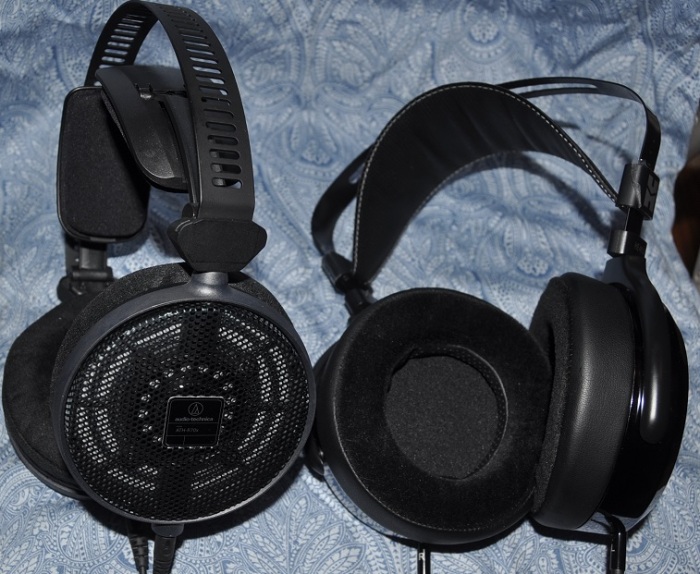
Both headphones with fully swiveled earcups
The metal gimbals and earcups feel sturdy although compared to the OPPO PM-1 both feel light weight and of cheap material. The amount of swivel on the 400i is far greater than the R70x because the 400i can swivel 90 degrees in either direction while the R70x is locked at 15 degrees in either direction. The lack of swivel on the R70x is in no way a hindrance during listening and both types of earcups contour nicely.
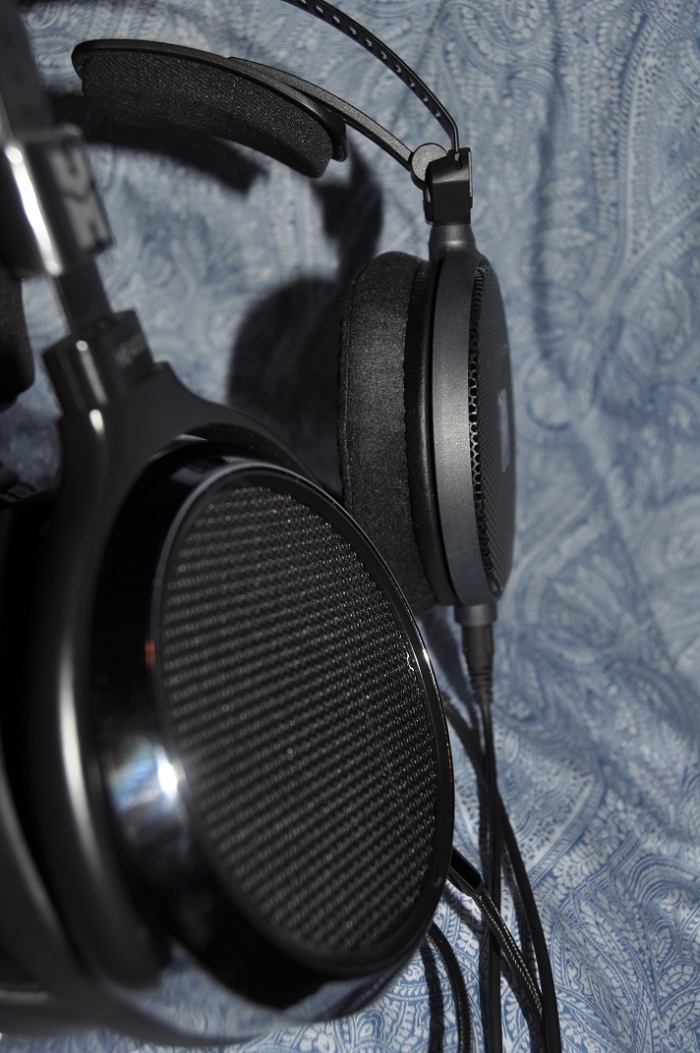
Showing the grills
The grills on the HE-400i are coated with a more robust coating. The R70x’s coating tends to scratch easily. The 400i’s earcups protrude passed the grills protecting them when they are lying around while the R70x will rest on the grills. The extreme open back of the R70x makes me worry that debris will build up in the driver area compared to the more protected HE-400i driver
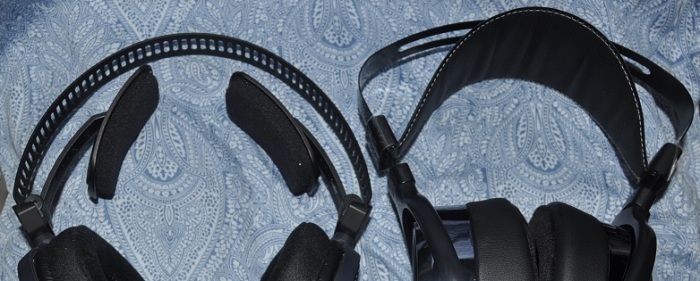
Headbands
The clamping force on either headband is never too tight and both feel light and supply adequate support. There are no ridges to worry about on either headband so no pressure points will develop like the headbands on some AKG and Sennheiser models. Expect extreme comfort with both headbands and lighter pressure and clamping with the 400i.
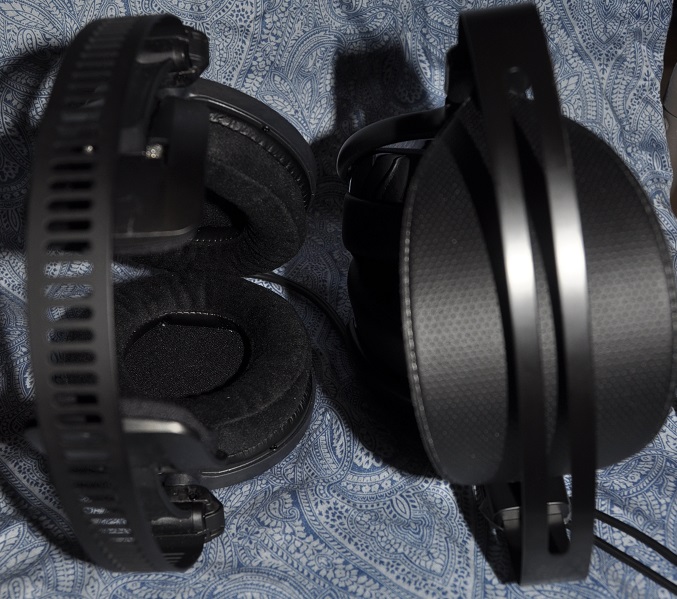
R70x ( Left ) , 400i ( Right )
It’s hard to tell whether the metal headband support on the R70x is high quality material or cheaply made because it is so light, roughly coated, and cut to alleviate any extra weight. The spring force and coating on the 400i headband is stronger and tends not to scratch compared to the R70x headband. The 400i is almost completely devoid of plastic while the R70x has plastic at the hinges and wings of the headband. Both headphones should be placed on a stand when not in use due their delicate nature, but neither will disappoint in general build quality.
ACOUSTICS
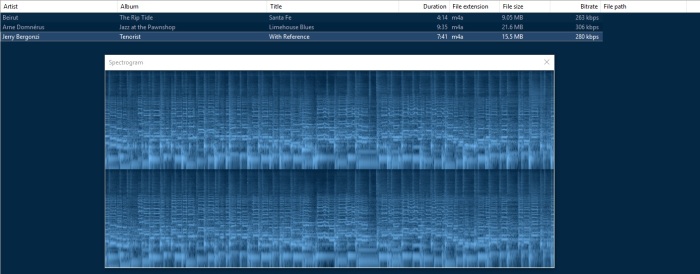
These headphones are desktop headphones. They are both reference quality and should be driven by a proper amp. I conducted my listening test using the following gear.
Amp: HeadRoom BUDA in single-ended mode
This has been my reference amp for years as it is very neutral, can drive anything I have, and can be used for balanced headphones. HeadRoom’s gear is designed with sonics and performance in mind and all of their stuff measures very well.
DAC: Schiit Bifrost ( 4490 )
I have had a few DACs and the Bifrost 4490 offered by Schiit Audio is one that competes with the best of them. It has a relatively small footprint and competes very well against my Grace Design m903 that I typically use as a DAC.
Tracks
Finding the right test tracks is key to identifying problems with a headphone. If the track does not have airy bass, vocals, multiple instruments, and lacks treble then it is likely going to mask issues that a headphone will have. These tracks cover a range of frequencies, genres, and include a variety of instrumentation.
Santa Fe by Beirut from the The Rip Tide album
An up-front sounding track that covers everything from crossover issues, vocals, drums, and overall music synergy. I use it to see if the midrange and treble is recessed on a headphone.
Limehouse Blues by Arne Domnérus from the Jazz at the Pawnshop album
Considered to be the best jazz recording of the 20th century this track delivers excellent sonics by capturing every detail of the jazz environment. Be it bass, snare, clarinet or sax this gem has it all.
Pink Noise by Ayre Acoustics on the Irrational, But Efficacious album
One of my favorite tracks used to test the general frequency response of a headphone. This track reveals the peaks and dips in the sound spectrum because it has equal energy at all audible frequencies. If something is out of place it will sound emphasized like extra bass, peaks in the treble, or if the headphone sounds biased to one side of the spectrum.
Reviews of the R70x and HE-400i can be consumed for their general sound signature and I will focus on the differences more than what they have in common. The immediate difference is how the R70x provides more air and sense of space to music. Instrument separation is more defined and the soundstage is less flat compared to the HE-400i. The 400i has a great soundstage, but due to some roll-off in the treble and slight lack of openness for the driver it sounds congested in comparison. I find the midrange of the R70x more up-front and the treble to be more spacious. This made me realize that it becomes fatiguing at average listening levels because the midrange is so up-front and the added treble extension over the 400i. If you’re sensitive to treble or hearing fatigue lean towards the 400i.
Santa Fe by Beirut from the The Rip Tide album reveals more treble detail with the R70x and there is more clarity in the vocals too. The 400i presents this track in a smoother and easier to listen to manor by reducing some of the midrange energy and trimming the bright nature of the R70x. Both headphones perform very well with this track and when the R70x is controlled on high gain on my amp sounds it sounds wonderfully detailed and bassier than expected.
Moving onto the Limehouse Blues by Arne Domnérus from the Jazz at the Pawnshop album and using the 400i it is clear I am missing some of the air that the R70x delivers. This track sounds overly neutral and lean without the R70x’s openness and added detail. The R70x introduces some tinniness to the upper midrange not heard with the 400i. I cannot help to find the R70x shies away from neutral here, but the instrument separation is superb. If you want a smoother sound the 400i is the way to go, but if you want to extract every detail in every tone the R70x is going to be the better choice.
Finally listening to Pink Noise by Ayre Acoustics on the Irrational, But Efficacious album shows the neutral sound signature of the 400i. Perhaps a touch of emphasis is heard in the lower midrange, but that is most likely an artifact of the linear and well-extended bass. I do find it strange how even the R70x sounds with this track be it a different nature than the 400i. While the 400i is linear the R70x is trebly and peaked in the midrange. The 400i produces more of a static sound and the R70x sounds like a rushing waterfall. It appears there is some bass emphasis to the R70x which does show up in the measurements as a broad peak from 30Hz – 100Hz.
CONCLUSION
Both the R70x from Audio Technica and HE-400i from HiFiMAN are competent headphones. They provide a fun sound signature without terrible bias in the bass or treble. The R70x delivers a clearer sense of space while the 400i remains smooth and easy on the ears. For how open the R70x is the bass is visceral and thumpy at times. The 400i relaxes the low end allowing for more attention to be made to the midrange and treble during bassy playback. The R70x would be my recommendation if it were less fatiguing and was less picky about amplification. Due to its 470 Ohm impedance a high gain amp is ideal and will add some oomph to the low end. On low gain my BUDA amp could not drive the R70x loud enough so getting the amplification right is key! On some tracks the bass of the R70x was distracting while the 400i made general listening easier due to its very linear frequency response.
If you are looking for a detail monster the R70x has you covered. If you are sensitive to treble and very up-front sounding headphones the 400i is going to be much easier on the ears and the lack of detail is not going to be huge. The R70x just adds in some air and crispness that the 400i struggles with. Both are surprisingly great headphones and I would not hesitate to recommend either with the understanding of how to amp the R70x and the linearity of the 400i’s bass.
Firstly, big thanks for the detailed comparison.
Secondly.. wow the results are very diiferent from what I expected.
From what I have read about the 400i and having lightly auditioned the R70x I expected that the R70x would be the smoother unfatiguing operator and the 400i would be the more detailed analytical one. It looks like its the other way around.
LikeLike
I was surprised that I liked the R70x so much. It sounds great, but does need a high-gain amp to control the driver properly which changes the sound signature.
LikeLike
Yeah I expected that it would be more popular in the head-fi forums but it seems that it doesn’t get much attention. Anyway any recommendations on the amp matching?
I have Ifi micro idsd and I consider buying the ifi iCAN as this combo is said to be a good match for the R70X.
The thing is now ifi is pushing the iCAN Special Edition which looks like it is more powerful than the normal iCAN. Advertised as “output power has been upped ten-fold to 4,000mW from 400mW”
Would the R70x benefit even more from that power increase?
LikeLike
It is less about power and more about impedance matching. So an ideal amp would follow the usual output power rules ( have enough to drive the cans to say 100 dB SPL ) but also have the ability to change the output impedance from low gain ( 3 Ohms or less ) to high gain ( 20 or more Ohms ). It is somewhat like adding a tube amp to change the sound signature of a headphone due to the harmonics that develop. The Ifi micro idsd has some output modes right like Normal and Turbo? You can try Turbo as that seems to be the high gain option. If you run out of headroom with it, which I doubt you will, then you can look into a more powerful amp.
LikeLike
The R70x and AD700x are probably very similar in soundstage and if you are looking at either for gaming the AD700x is much less expensive. Since I have not heard the AD700x I cannot comment on how they compare, but to me I like to use a closed headphone for gaming because closed headphone isolate better and better separate left/right making it easier to locate where a footstep etc might be coming from.
LikeLike